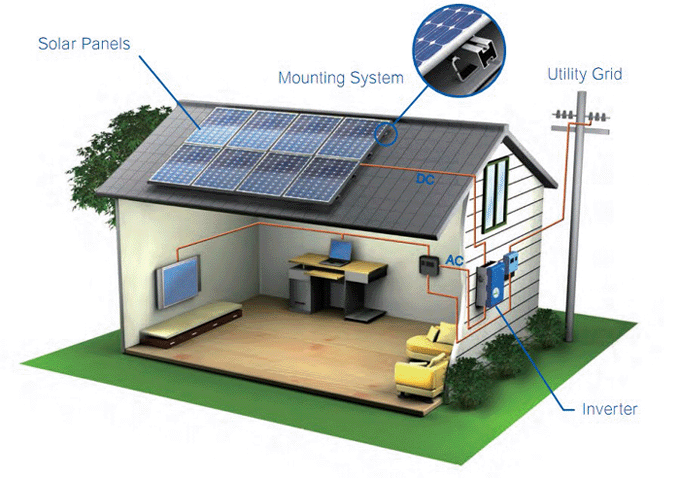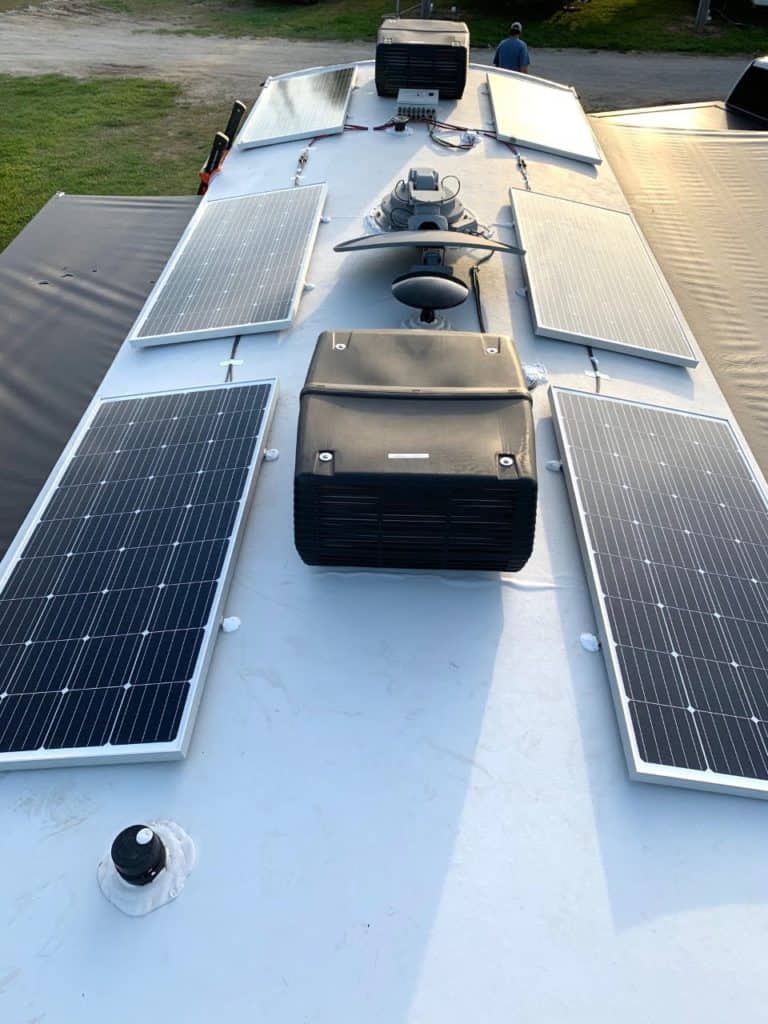Essential Steps to a Successful Solar Installation
Checking Out the Various Sorts Of Solar Panels and Their Special Benefits
The landscape of solar panels offers different alternatives, each with distinctive advantages suited to different applications. Monocrystalline panels stick out for their performance and aesthetics, while polycrystalline models interest budget-conscious customers. Thin-film technology offers versatility in installment. Cutting-edge styles like building-integrated and bifacial photovoltaics better enhance the appeal of solar power. Understanding these distinctions is crucial for making educated decisions. The concern continues to be: which kind will best fulfill details power requirements?
Monocrystalline Solar Panels
Although numerous sorts of solar panels are readily available, monocrystalline solar panels are typically considered as one of the most efficient option. These panels are made from a solitary crystal framework, generally silicon, which permits them to transform sunshine right into electrical energy better than various other kinds. The effectiveness rates for monocrystalline panels can range from 15% to over 22%, making them a popular choice for household and business installations where room is limited.

Polycrystalline Solar Panels
Polycrystalline solar panels are generated utilizing a distinctive production procedure that includes melting several silicon crystals together. This method can result in benefits such as lower manufacturing costs, making them a prominent selection for lots of customers. Their efficiency and efficiency variables might differ compared to various other types of solar panels, warranting mindful factor to consider.
Manufacturing Refine Benefits
The production process of polycrystalline solar panels supplies a number of advantages that add to their charm in the renewable resource market. The production makes use of silicon scrap, which minimizes waste and decreases material prices, making it financially feasible. Unlike monocrystalline panels, the manufacturing of polycrystalline panels entails easier and less energy-intensive methods, resulting in a smaller sized carbon footprint. In addition, the casting procedure enables the development of multiple cells at the same time, improving efficiency in manufacturing. This method likewise leads to an extra uniform framework, which can improve the general efficiency and longevity of the panels. Polycrystalline solar panels offer a cost-efficient option for customers while promoting lasting manufacturing techniques within the market.
Efficiency and Performance Factors
Just how do effectiveness and efficiency factors affect the efficiency of polycrystalline photovoltaic panels? These panels commonly exhibit reduced efficiency rates, balancing around 15-20%, contrasted to their monocrystalline equivalents. Aspects such as temperature level sensitivity, shading, and the angle of installation substantially impact their efficiency. Polycrystalline panels often tend to perform far better in cooler climates however may struggle in high temperature levels, leading to minimized result. In addition, their performance can be impacted by dust and particles accumulation, demanding regular upkeep. Regardless of these obstacles, polycrystalline panels are more budget friendly and offer a solid balance between expense and performance. Recognizing these efficiency and performance factors is essential for customers looking for to maximize solar power manufacturing and total system performance.
Thin-Film Solar Panels
Thin-film solar panels represent a versatile and light-weight alternative in the solar energy landscape. These panels are constructed by transferring several thin layers of photovoltaic or pv product onto a substrate, which can include glass, plastic, or steel. This production process allows for higher versatility in layout and applications compared to traditional crystalline photovoltaic panels.
Thin-film innovation usually features lower performance rates, yet it makes up for this with reduced production expenses and boosted performance in low-light conditions. Their lightweight nature makes them ideal for installation on different surface areas, including bent frameworks and cars. Additionally, these panels can be integrated right into building products, providing visual advantages along with energy generation.
Bifacial Solar Panels
Bifacial solar panels are obtaining attention for their boosted efficiency and efficiency, as they can catch sunshine from both sides. This dual-sided layout enables for raised energy manufacturing, particularly in reflective atmospheres. Furthermore, their installation supplies potential expense advantages, making them an appealing alternative for different applications.
Performance and Efficiency
The effectiveness and efficiency of solar panels are important variables in determining their effectiveness in energy generation, with bifacial solar panels standing out for their innovative style. These panels include solar batteries on both sides, enabling them to capture sunshine from numerous angles. This dual-sided ability boosts power output, particularly in environments with reflective surfaces, such as snow or sand. Bifacial solar panels can raise power manufacturing by 10-20% contrasted to traditional monofacial panels. Their ability to harness indirect sunshine adds to their general effectiveness, making them a compelling option for various applications. Additionally, innovations in modern technology proceed to boost their efficiency metrics, strengthening their area in the renewable resource landscape as an extremely reliable remedy for solar power generation.
installation and Expense Advantages
When taking into consideration the benefits of bifacial solar panels, the installation process and expense benefits are considerable aspects that can affect decision-making for both domestic and business applications. Bifacial panels can be installed on various structures, including rooftops and ground installments, permitting functional implementation. Their capability to take in sunshine from both sides enhances energy generation without calling for added panels. This effectiveness can cause lowered general installation costs, as fewer systems might be required to attain preferred energy outputs. Furthermore, their durability often equates to reduce maintenance expenditures over time (Solar Company). Consequently, the lasting financial advantages, combined with installation versatility, make bifacial solar panels an enticing selection for those looking for sustainable power options
Building-Integrated Photovoltaics (BIPV)
Building-Integrated Photovoltaics (BIPV) stand for a substantial evolution in solar modern technology, perfectly integrating solar cells into structure materials such as home windows, roofing systems, and frontages. This innovative approach not just generates renewable resource yet additionally improves the aesthetic appeals and capability of buildings. BIPV systems can change standard structure materials, decreasing the general expense of building and construction while contributing to energy efficiency.
The combination of solar innovation into architectural style permits far better my blog space application, as these systems can be installed without requiring additional land. Furthermore, BIPV options are personalized, making it possible for architects to create unique layouts that enhance the structure's overall appearance. The dual capability of BIPV-- offering both as a power generator and a structural element-- uses considerable benefits in metropolitan settings where room is restricted. As awareness of sustainable structure techniques expands, BIPV is coming to be an increasingly eye-catching choice for designers and house owners alike.
Concentrated Photovoltaic (CPV) Solutions
Concentrated Photovoltaic (CPV) systems represent a sophisticated solar innovation that mirrors or makes use of lenses to focus sunlight onto high-efficiency solar batteries. This cutting-edge technique wikipedia reference permits the collection of substantially more solar power than traditional photovoltaic or pv systems. By focusing sunshine, CPV systems can attain greater performances, usually surpassing 40%, making them particularly appropriate for areas with high direct sunlight.
Furthermore, CPV systems typically need much less land area contrasted to traditional solar panels, as they produce even more power from a smaller sized footprint. These systems frequently incorporate monitoring mechanisms that change the placement of the lenses or mirrors to adhere to the sunlight's movement, making best use of power capture throughout the day. Nevertheless, CPV technology is best fit for certain geographic places, where straight sunlight is bountiful, restricting its applicability in regions with frequent cloud cover. On the whole, CPV systems provide an encouraging choice for boosting solar energy production in suitable environments
Contrast of Photovoltaic Panel Performance and Cost
Numerous solar panel technologies exist, their efficiency and price can significantly differ, affecting consumer choices and market dynamics. One of the most common kinds-- polycrystalline, monocrystalline, and thin-film-- show distinct features in efficiency and pricing. Monocrystalline panels often tend to offer the greatest effectiveness rates, typically exceeding 20%, yet they normally come with a higher price. On the other hand, polycrystalline panels are usually a lot more budget-friendly, with effectiveness around 15-20%, making them a popular option for budget-conscious consumers. Thin-film innovations, while less reliable at around 10-12%, supply adaptability and lower installation prices, appealing to particular applications.
Inevitably, choosing the right solar panel includes evaluating the equilibrium between effectiveness and expense. Customers must consider their energy site needs, budget restrictions, and long-lasting savings capacity, as these variables will certainly dictate the best selection for their solar energy system.
Regularly Asked Inquiries
The Length Of Time Do Solar Panels Usually Last Prior To Needing Replacement?
Solar panels typically last in between 25 to 30 years prior to requiring replacement. Their toughness depends upon different factors, including top quality, installment, and local environmental problems, which can affect their performance and long life over time.

Can Solar Panels Operate In Cloudy or Rainy Conditions?
Solar panels can certainly function in rainy or over cast conditions, albeit at lowered effectiveness. They still catch scattered sunlight, enabling for power generation, though power outcome may be substantially less than on warm days.
What Upkeep Is Required for Solar Panels?
Routine maintenance for solar panels includes routine cleaning to eliminate dust and particles, evaluating for damages, making sure connections are secure, and reviewing system efficiency. Regular exams can enhance performance and prolong the life-span of the panels.
Are There Any Kind Of Environmental Influences From Manufacturing Solar Panels?
Yes, producing solar panels can have ecological effects, consisting of source extraction, energy consumption, and waste generation. Innovations in modern technology aim to reduce these impacts, advertising even more lasting methods in production and reusing procedures.
Just how Do I Choose the Right Solar Panel for My Home?

Various types of solar panels are offered, monocrystalline solar panels are typically regarded as the most reliable choice. Thin-film solar panels represent a lightweight and flexible alternative in the solar power landscape. The effectiveness and efficiency of solar panels are essential aspects in determining their performance in power generation, with bifacial solar panels standing out for their ingenious style. Building-Integrated Photovoltaics (BIPV)
Building-Integrated Photovoltaics (BIPV) represent a significant evolution substantial advancement technology, innovation incorporating effortlessly cells into building materials structure as roofing systems, roofs, and facades. Concentrated Photovoltaic (CPV) systems represent an innovative solar innovation that mirrors or uses lenses to concentrate sunlight onto high-efficiency solar cells.